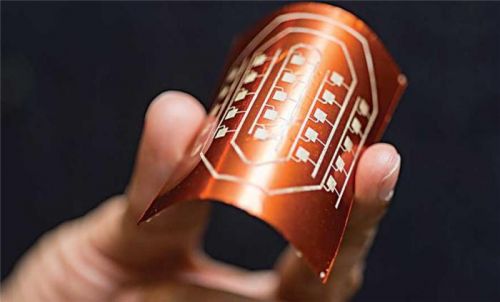
According to foreign media reports, as of 2030, electronic components will account for 50% of the total cost of automobiles. However, at the beginning of this century, it accounted for only 30%. As the number of vehicle components increases, packaging and weight have become major issues for automotive engineers. Manos Tentzeris, professor of electrical engineering at Georgia Tech, proposed an alternative solution – the new flexible printed electronics.
The characteristics of this type of component are that its circuit board and electronic system can be bent, folded, and extended, and the function will not be affected. The manufacturing principle is as follows: a conductive ink is coated on a flexible surface, and a mechanical device is used to manufacture a flexible printing element, which is then fabricated into an electronic system.
As a professional in the field of flexible electronic components, Professor Manos Tentzeris said: "Hybrid electronics involves a variety of electronic components, including: logic components, memory, sensors, batteries, antennas and various passive components, manufacturers may adopt Printed manufacturing techniques or assembly methods place electronic components on flexible substrates."
Tentzeris added: "In combination with low-cost manufacturing processes, flexible hybrid electronic components will introduce a new product paradigm that can be used in a variety of automotive applications."
Such components may also be used in the following applications: "antennas, body parts, cockpits, speakers, mounting structures and sensors. In addition, flexible electronic components can be incorporated into bumpers, heads-up displays, dashboards, seats , tires, windows and many other auto parts."
According to Tentzeris, flexible electronic components can be printed directly onto the surface of various materials or components using printed manufacturing techniques. Suitable materials include: fiber, glass, plastic and wood materials, and withstand temperatures above 250 °C.
Another fascinating aspect of this technology for automotive engineers is the ability to achieve weight reduction (lightweight). According to Tentzeris: "Flexible electronic components are 60%-80% lighter than conventional chip devices." In addition, these components have other advantages, such as: the price of printed electronic components is not expensive, can be applied to various materials Made in large panels.
Tentzeris has worked with colleagues on the development of flexible electronic components for 12 years. They conducted numerous tests to repeatedly bend, extend, and twist components at different temperatures to test for changes in mechanical and electrical properties.
Currently, they are working on a research and development project provided by Boeing to create a flexible array antenna that will be integrated into the aircraft fuselage or car body in the future.
They also conceived a variety of new automotive applications, such as injection molded electronic components, organic light-emitting diode (OLED) displays. At present, GSI Technologies LLC and TactoTek Inc have commercialized flexible printed electronic components technology.
Faurecia has also recently invested in TactoTek and is currently working on integrating printed circuits and electronic components into molded plastic parts to create "intelligent surfaces".
Visteon is exploring new ways to integrate flexible electronic components into its products. Earlier this year, Visteon released a purely digital dashboard with a curved display that uses flexible OLED technology. Compared to the traditional LCD screen used in the instrument panel, the OLED is thinner and more flexible, and its operation does not require backlight support.
Product categories of Stylus Pen For Huawei, which is just for Huawei M5, M6, C5, Matebook E, other tablets can not be used. Pls check with your huawei tablet model before ordering. We have advanced production equipment, strong software and hardware development capabilities. We have the perfect after-sale service and technical support. Looking forward to our cooperation.
Stylus Pen For Huawei,Surface Pen,Touch Pen,Touch Screen Pen
Shenzhen Ruidian Technology CO., Ltd , https://www.wisonens.com